IUCN/SSC Otter Specialist Group Bulletin

©IUCN/SCC Otter Specialist Group
Volume 40 Issue 4 (October 2023)
Citation: Narasimmarajan, K., Hayward, M.W., Palanivel, S., and Mathai, M.T. (2023). Population Status and Temporal Activity Pattern of two Vulnerable Otter Species from Camera-Trapping in the Southern Western Ghats Biodiversity Hotspots. IUCN Otter Spec. Group Bull. 40 (4): 183 - 196
Population Status and Temporal Activity Pattern of two Vulnerable Otter Species from Camera-Trapping in the Southern Western Ghats Biodiversity Hotspots
Kannadasan Narasimmarajan1*, Matthew W. Hayward2, Sonaimuthu Palanivel3, and Manu Thomas Mathai1
1Department of Zoology, Madras Christian College, Tambaram, Chennai – 600059, India
2Conservation Science Research Group, University of Newcastle, Callaghan, NSW 2308, Australia
3PG Department of Botany, The New College, Royapettah, Chennai – 600 014, India
*Corresponding Author Email: Wildlife9protect@gmail.com
Received 25th March 2023, accepted 19th July 2023
Abstract: India is moving towards having the highest number of threatened species in th world, yet since the turn of the twenty-first century some flagship species, such as otters, have been poorly studied in their natural habitats. Here, the population and temporal activity patterns of two sympatric otter species i.e., the Smooth-Coated Otter, Lutrogale perspicillata, and the Asian Small-Clawed otter, Aonyx cinereus nirnai, were studied using 233 photographs from camera traps between March 2015 and September 2017 on the Moyar River in the Western Ghats biodiversity hotspot, India. We categorized the activity patterns of the two otter species by calculating the photo-capture rate at different seasons, and then evaluated the pooled temporal activity and overlaps by calculating the overlap coefficients. Smooth-Coated Otter temporal activity was strong late at night and before mid-day (≥ 95% records between 0100 and 1200 hours). Asian Small-Clawed Otter activity was primarily in the early morning and afternoon (≥ 95% records between 0400 and 1800 hours). We found high temporal activity overlap (∆1≥ 0.75) between Small-Clawed and Smooth-Coated Otters (95% CI = 0.62–0.88). Temporal activity overlap was high because of morphological and ecological guild differences between these two otter species that suggest a lack of temporal niche segregation. In addition, the broad dietary breadth may compensate for the high temporal niche overlaps among these two otters. Activity pattern, and temporal niche partitioning among the sympatric otters by camera-trapping was useful to establish effective conservation measures for the aquatic carnivore conservation in the Western Ghats region.
Keywords: Temporal activity pattern; Sympatric otters; Camera traps; Moyar River; Western Ghats; Conservation management
INTRODUCTION
Owing to their elusive nature, the current status of otter populations, resource use and activity patterns in the Indian subcontinent are inadequate (Hussain, 2013). In particular, there are few detailed otter studies from the southern Western Ghats of India (Narasimmarajan et al., 2021; Raha and Hussain, 2016; Perinchery et al., 2011; Anoop and Hussain, 2004). Studies on otter ecology have been done sporadically in India (Hussain, 1993; Sathyanarayana, 1997; Nawab, 2010; Narasimmarajan, 2020), however detailed knowledge on their activity patterns in the wild is little known (Hussain, 2013; Palei et al., 2020). Many animal species exhibit an endogenous rhythm of activity that approximates a diel cycle or twenty-four-hour period (Harker, 1964; Eisenberg, 1981). The question is whether such a rhythm is present in a semi-aquatic carnivore like otters. Smooth-coated and Asian small-clawed otters are listed as Vulnerable species under the IUCN Red list (Hussain, 1993). They are elusive animals and are listed as Schedule I species of India’s Wildlife (Protection) Act, 1972 (Prater, 2005). In the Western Ghats, otters are facing pressure due to hydro-electric dams, indiscriminate fishing, illegal poaching, habitat degradation, pesticide runoff, pollution and retaliatory killing by fishermen who see otters as a competitor depleting their fish stocks (Perinchery et al., 2011; Narasimmarajan et al., 2021).
Studying temporal activity patterns of otters could help to understand their seasonal spatial movement in response to the resource availability, the potential for competition, and the optimal times to monitor the species. In this study, we measured the population status and temporal activity pattern of two Indian otter species using a broad-scale dataset collected from field surveys in the entire river and 22 camera trap locations across the Moyar riverscape, Western Ghats biodiversity hotspot, and quantify the temporal activity overlap between these two otter species.
MATERIAL AND METHODS
Study Area
The Moyar River is 102 km long. Originating in upper Bhavani at 2054 masl, it flows through several protected areas, namely Mudumalai Tiger Reserve (Mudumalai), Sathyamangalam Tiger Reserve (Sathyamangalam), Nilgiri North and South Divisions, and ends in Bavanisagar dam at 254 masl (Narasimmarajan et al., 2021; Figure 1). The upper reaches of the river receive ~5,000 mm of rainfall, whereas the downriver reaches receive ~824 mm of rainfall annually (Puyravaud and Davidar, 2013). The minimum and maximum annual average temperatures in this region vary from 14 ˚C – 30 ˚C in higher elevations, and 25 ˚C -38 ˚C in the lower elevations (Narasimmarajan et al., 2019; Puyravaud and Davidar, 2013). The elevation of the river varies from 2,054 masl (Pykara Dam) to 250 masl (Bavanisagar Dam) (Narasimmarajan et al., 2021). The Moyar landscape supports the large population of Bengal Tigers (Panthera tigris), Leopards (Panthera pardus), Asian Elephants (Elephas maximus), Otters (Lutrogale perspicillata; Aonyx cinereus nirnai), Indian wilddogs or dholes (Cuon alpinus) and endangered vultures such as Gyps benghalensis, Gyps indicus; Neophron percnopterus, and Aegy piusmonachus (Narasimmarajan, 2020; Puyravaud and Davidar, 2013).
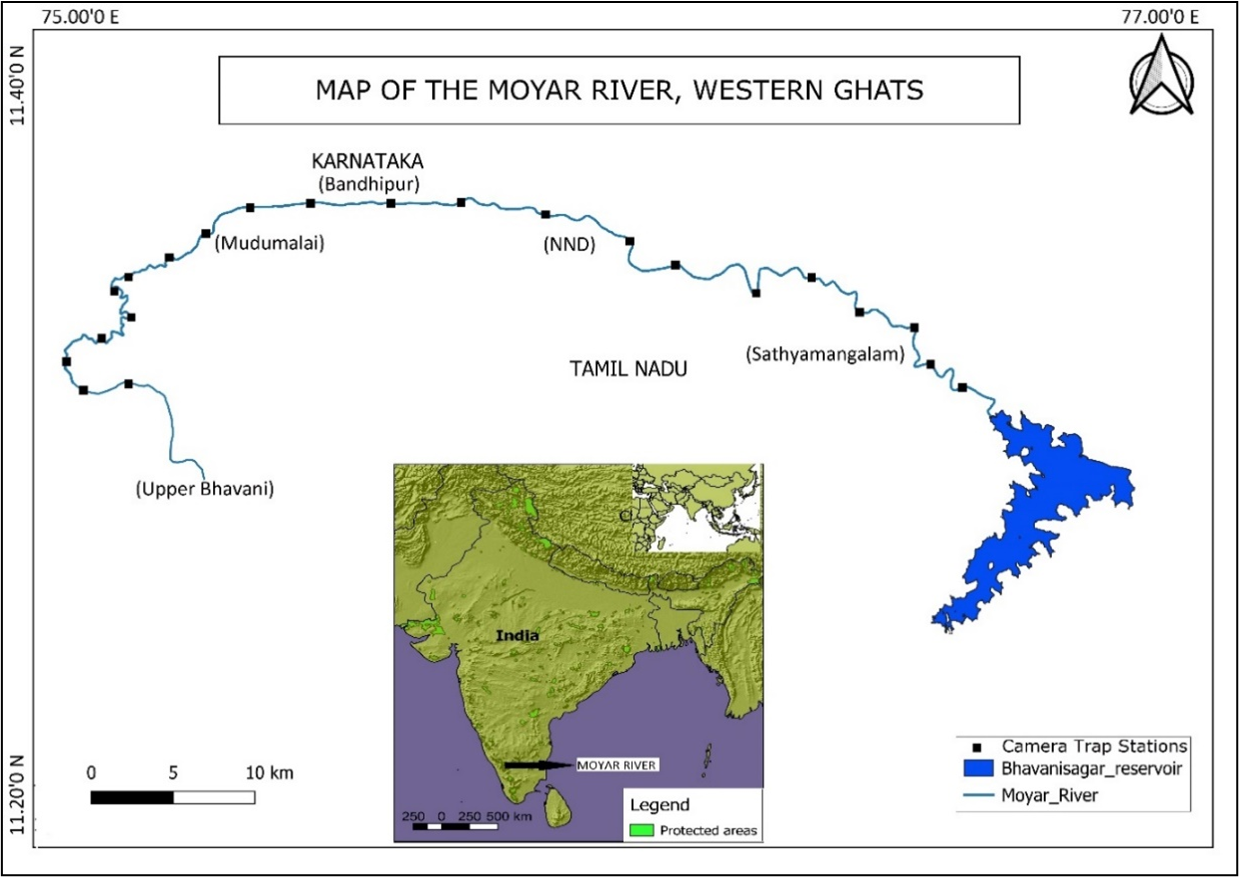
The Moyar River is an important source of irrigation for thousands of hectares of agricultural land and supports the livelihoods of more than a million people (Puyravaud and Davidar, 2013). However, this river ecosystem faces constant threats, such as agricultural pesticide runoff, hydro-electric projects, unrestricted illegal fishing activities, and the spilling of motor oil (Narasimmarajan, 2020). In addition, non-indigenous wattle (Acacia melanoxylon) and mesquite (Prosopis juliflora) continues to invade the river gorges, affecting catastrophically the native riparian vegetation (Narasimmarajan et al., 2021).
Study Species
Smooth-Coated Otters (Lutrogale perspicillata) are characterized by very smooth, sleek pelage (Figure 2A). Their eyes and ears are small, the tail is flat, limbs are short, strong, and the fore and hind paws are large and well-webbed. These otters have generally been described as fish specialists. Total body length can be up to 1.3 m and weight up to 7-11 kg. They live in pairs but are also observed in family groups of up to 3-5 individuals.
The Asian small-Clawed Otter (Aonyx cinereus nirnai) is the smallest otter species in the world (Figure 2B). It has short claws that do not extend beyond the pads of its webbed digits and rounded tails. Total body length of this species is around 0.50 to 0.70 m and weight up to 4.5 kg. These otters live in riverine habitats, freshwater wetlands and mangrove swamps, and paddy fields, and feed on molluscs, crabs and other small aquatic animals. They live in large family groups of up to 15-20 individuals.
Both the otter species utilise different habitats within the same aquatic ecosystem because their resource use patterns and food habits are completely divergent (Narasimmarajan, 2020).
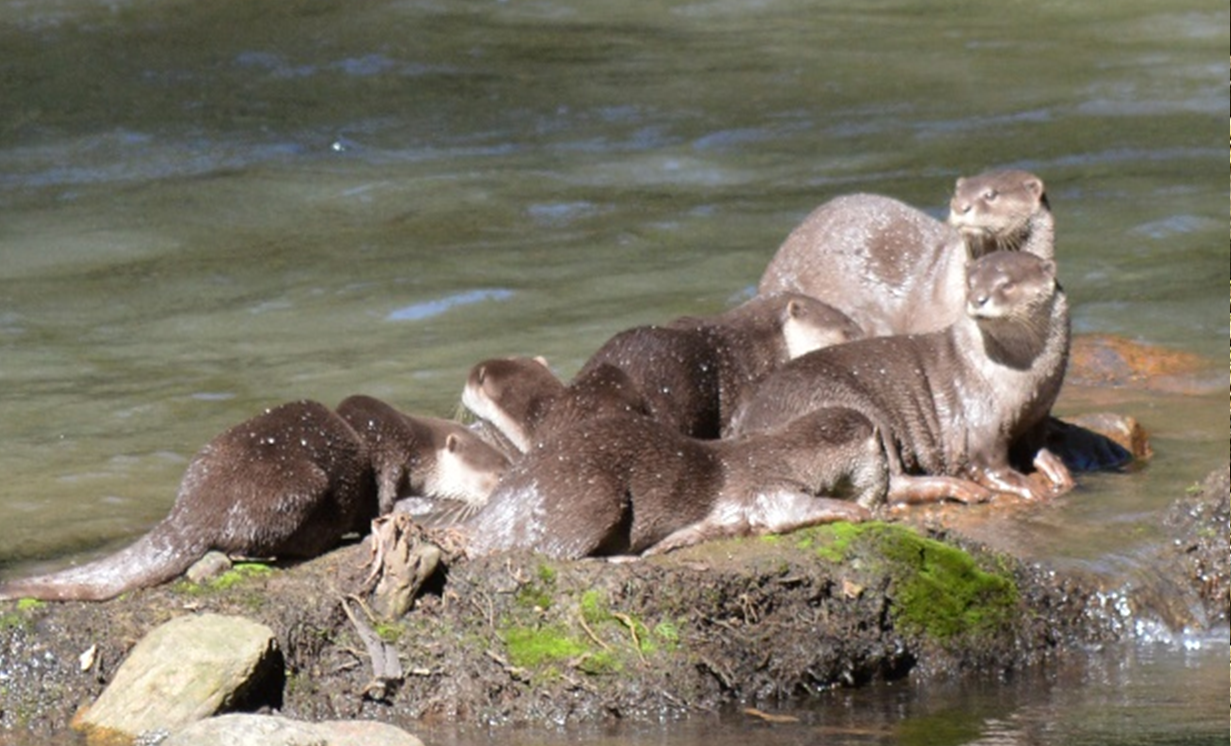
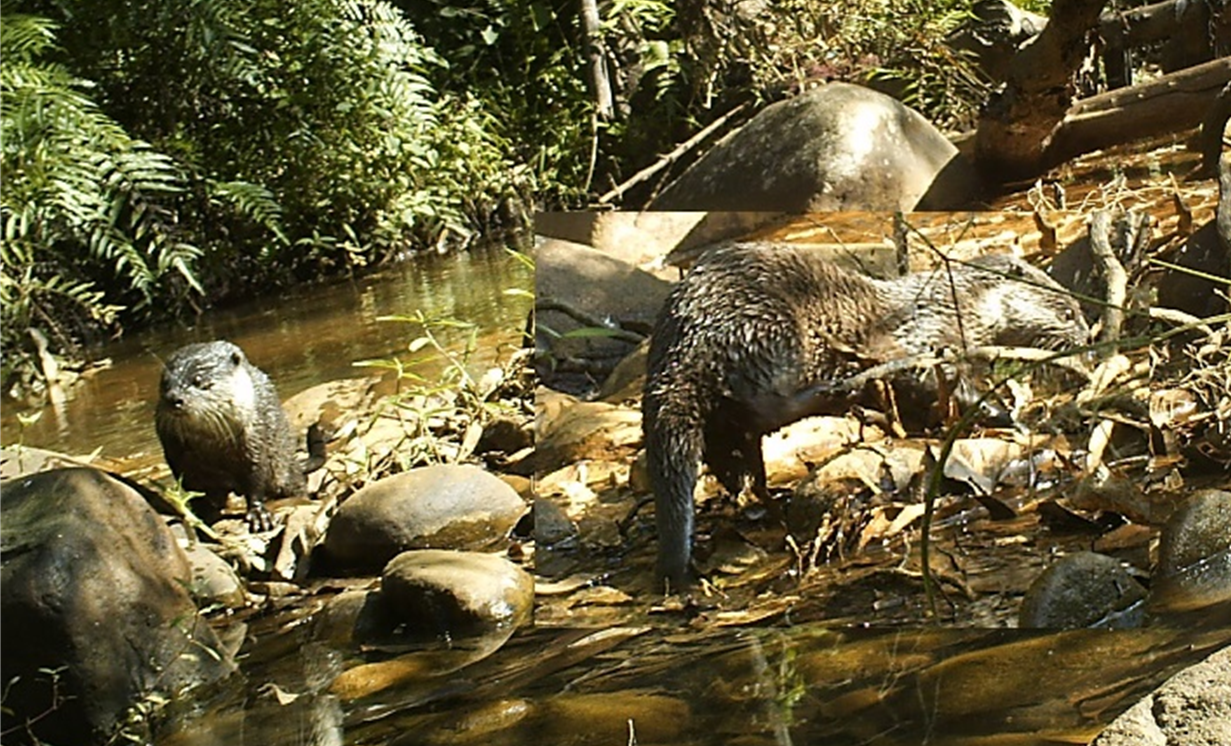
B: The Asian small-clawed otters were pictured by camera traps at Northenhey (987 m asl) in the River Moyar where the river was very shallow water, narrow with lots of boulders (right).
Data Collection
Field Survey
The entire Moyar Riverbank was surveyed in post-monsoon (September - November), winter (December - February) and summer (March - June) seasons between March 2015 and September 2017, following the methods described by Narasimmarajan et al. (2021), Nawab (2010), and Hussain (1993). Whenever otters were spotted, date, species, group size, time, elevation and environmental variables were recorded in a prescribed datasheet (Narasimmarajan et al., 2021). The field data was used to estimate the seasonal population abundance of the two otter species using simple statistics (Anoop and Hussain, 2004). Population abundance was calculated using the formula:
Camera Trap Survey
Camera trap surveys provide valuable information on species temporal activity pattern if used systematically and for a long duration (Ridout and Linkie, 2009). Each camera trap records the date and time of each photograph, which can be used to analyse the temporal activity pattern of a species in an area (Ridout and Linkie, 2009). This method has an advantage over physical trapping done for capturing small mammals as trapping records an animal’s presence at some point during the period between trap setting and trap servicing, whereas camera traps provide a much longer time frame, limited only by camera memory capacity, with automatic triggering when an animal is present (Ridout and Linkie, 2009), without stress to the animal. Twelve automatically triggered cameras (Bushnell Trophy Cam 8MP HD Video Scouting Game Security Trail Camera119537C) were deployed across 22 different locations with different elevation gradients along the Moyar River (5-30-day intervals) (Table 1). The camera trap sites were selected based on high density of indirect otter evidence such as spraints, grooming sites and dens that had been observed. The temporal activity pattern of the two otter species along the river Moyar was calculated using the camera trap pictures to determine the species’ activity pattern, variation and overlap in activity patterns. The cameras were operated continuously for 24 h at each site. The photo capture success rate is the ratio of independent photo events to whole camera trap days, multiplied by 100 (Rovero and Marshall, 2009). The number of independent images of otters from camera traps in the Moyar River was used to determine the season-wise photo capture rate.
Activity Pattern Analysis
Our camera-traps only recorded activity at ground-level, capture times for each species were regarded as a random sample of photographs taken at any time of a day. The day-night cycle remains constant throughout the year within the study site, mostly the sunrise occurs at 0600h and sunset at 1800h, local time (GMT +8) respectively. We estimated the daily activity pattern and temporal overlap between sympatric otter species by applying the statistical methodology developed by Ridout and Linkie (2009). We computed each species terrestrial activity pattern separately using kernel density estimation or by fitting trigonometric sum distributions (Fernández-Durán, 2004). Then, a measure of overlap between two focal species distributions was calculated. Ridout and Linkie (2009) favoured the coefficient of overlapping, Δ, which is defined as the area under the curve that is formed by taking the minimum of the two density functions at each time point. The coefficient of overlap = 1 if the activity densities are identical and = 0 if they have no common active period.
We obtained confidence intervals as percentile intervals from 1000 bootstrap samples. All statistics were performed in R version 2.11.1 (R Core Team, 2021) following the code made available by Linkie and Ridout (2011). We used the estimator for the coefficient of overlap because it is recommended for small sample sizes (Ridout and Linkie, 2009). Δ1 is a label consistent with discussions in Ridout and Linkie (2009) and is defined as:
We first calculated the coefficient of overlap for activity Δ1 of the observed data using function overlapEst from the R package overlap (Meredith and Ridout, 2016). Δ1 is the integral defining the area under the probability density functions of the estimated daily activity density curves of both otter species (denoted by ƒ (t) and g (t)) (Ridout and Linkie, 2009).
Population Abundance of Smooth-Coated (Lutrogale perspicillata) and Asian Small-Clawed Otters (Aonyx cinereus nirnai)
A total of 14 direct sightings of Smooth-coated otters were made (59 adults and 13 juveniles) with a mean group size was 5.14 ± 0.8 individuals and the encounter rate of otter group/km was 0.18, 0.39 and 0.42 during post-monsoon, winter, and summer. A total of 8 direct sightings of Asian small-clawed otters were made (36 adults and 4 juveniles) with a mean group size of 5.77 ± 0.9 individuals and the encounter rate was 0.06, 0.18 and 0.76 during post-monsoon, winter and summer (Table 2).
Photo Capture Representation of Two Otter Species
Total camera trap effort was 3917 trap-days in which the Smooth-Coated Otter accounted for 2327 trap nights and 1590 trap-days for Asian Small-Clawed Otters. The Smooth-Coated Otter photo capture rate was highest during winter but reduced gradually during summer. However, the Asian Small-Clawed Otter photo captured frequency was higher during summer but reduced after the post monsoon (Table 3).
Our observations show that both the otters were diurnal and late night in their activity behaviour. The Smooth-Coated Otter was photo-captured more during winter (36.1%), moderate post monsoon (34.7%) and less captured in summer (29.2%). The Asian Small-Clawed Otters were more frequently captured during summer (56.2%), followed by winter (33.3%) and very low in post-monsoon (10.4%).
Temporal Activity Pattern of the Two Otter Species
In general, otters are nocturnal and very secretive in nature but in the River Moyar, the Smooth-Coated appears to be more active during late night and daylight hours i.e., late at night, mid-day and late evening hours 0100 to 1200 and 1700 to 1900 hours, and Asian Small-Clawed Otters were more active during late night and mid-day hours, 0400 to 1800 hours. Despite this, both otter species showed peak activity in the morning (Figure 3A & B).
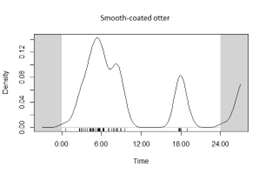
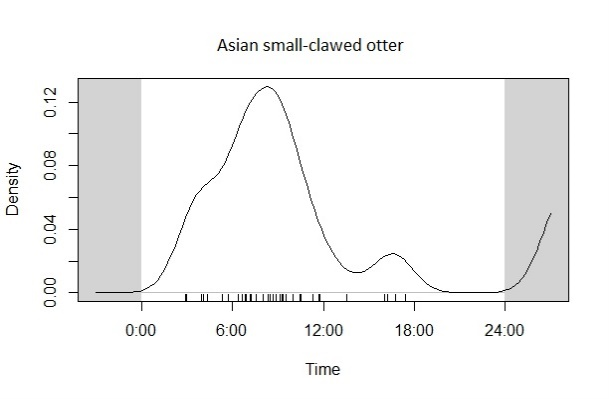
The activity pattern of Smooth-Coated Otters in the Moyar River exhibited a bimodal curve, in which two period of high activity were separated by a period of relative inactivity. The first active period started after late night and continued until early morning (0100 - 1200 hours), then there was a second active period which continued from approximately 1700 - 1900 hours; 1300 to 1700 and 1900 to 0100 hours no activity was been captured, perhaps due to resting in the dens. The period when inactivity was most common was 1900 - 0100 hours. The Asian-Small Clawed Otter diel activity pattern was unimodal (diurnal), with the peak activity occurring between 0400 to 1900 hours. Therefore, no activity was captured during 1900 to 0400 hours. A difference was also found between daytime and night-time activities. Estimated activity pattern overlap (Δ1) between two otter species (1 = identical activity), with approximate 95% bootstrap confidence intervals in parentheses 0.75 (0.62 - 0.88) (Figure 4).
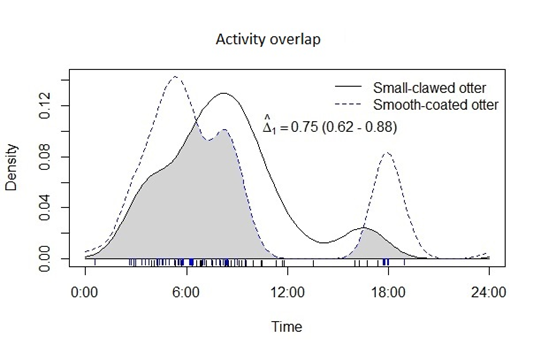
DISCUSSION
The present study could help better understand otter behaviour in this region. To our knowledge, this is the first field survey and camera trap-based data on encounter rate and activity patterns of two sympatric otters in their range in the Western Ghats. However, we were unable to assess the season-wise diel activity pattern of these two otter species’ due to inadequate photo-capture numbers during summer for Smooth-Coated Otter and all seasons for Asian Small-Clawed Otter (Table 3). Therefore, it is difficult to compare this encounter rate with those from any other studies. Palei et al (2020) stated that the Smooth-Coated Otter showed bimodal peaks in its activity; the first peak was observed from early morning to mid-day and the second smaller was in the late afternoon. Although Smooth-Coated Otters were active throughout the day, they exhibited reduced activity during the hottest hours of the day in Bhitarkanika National Park (Palei et al., 2020). Therefore Smooth-Coated Otters in the Moyar River exhibited bimodal peaks in activity during late at night, mid-day hours with low levels of activity in the late evening. Conversely, Asian Small-Clawed Otters exhibited unimodal peaks in activity during late night to evening in River Moyar.
The findings indicate that the temporal activity patterns of Smooth-Coated Otter in the Moyar River was mainly diurnal with bimodal peak and so this study broadly differs from the results of Hussain (2013) in the River Chambal, and Wei et al. (2020) in Sabah, Malaysia Borneo, who both stated that Smooth-Coated Otters were completely crepuscular. However, the findings do agree with some other Smooth-Coated Otter studies, which suggest that this species is mainly diurnal (Foster-Turley, 1992; Khan et al., 2010; Kruuk, 2006; Rosset al., 2013; Palei et al., 2020).
Conversely, the Asian small-clawed otter exhibited predominantly diurnal activity in the Moyar River, beginning in the early hours of the morning (0400 hours) and continuing to early evening (1900 hours). The increasing detections of the Asian small-clawed otters during summer could be due to the drying up of uphill stream habitats, which leads the otters to migrate towards the downriver where they find plenty of food, suitable habitat and breeding dens (Perinchery et al., 2011).
We did not record overlapping pictures of these two otter species in any of the 22 camera trap stations. This could be because the habitat requirement of these two otter species was completely divergent in the Moyar river. During the survey, three Asian small-clawed and four Smooth-coated otter active dens were seen beneath wild mango Mangifera indica trees. Similarly, Hewson (1969) reported that the Eurasian otters in Scotland had a positive association with Rhododendron, which occurs as a weed in many areas. This is a novel finding of the positive association between otters and wild mango trees, but further detailed study is required to understand the relationship between otters and their habitat traits, which would bring to light many more facts about social bonding and breeding biology of otters.
Conservation Implications
This paper describes the population status and activity patterns of two elusive otter species in the southern Western Ghats. The temporal activity of the two otter species is probably determined by resource availability and other environmental factors. This paper highlights the value of adopting modern scientific techniques, such as camera trapping, to help researchers and conservation agencies develop datasets to assess ethological characteristics of lesser-known elusive species.
In view of the rather unique geographical location of the Moyar River, and the corollary issues of existing dams and other anthropogenic pressure with the endangered fauna like otters, the in-place management strategies for Protected Area Management need to be re-examined (Narasimmarajan., 2020). We therefore propose that a framework based on Adaptive Management (AM) for reconciling conservation and development goals in the Moyar River ecosystem is needed. Therefore, further detailed research should be focused on otters beyond protected areas in order to have better understanding and management of the species in the human-dominated landscape. This information is critical if we are to leave future generations with the opportunities to experience nature that current generations have had (Hayward et al., 2022).
Acknowledgements: Authors thank their respective institutions for supporting the research activities. Special thanks to Tamil Nadu Forests Department for providing the necessary research permission. Field Directors (Sathyamangalam Tiger Reserve & Mudumalai Tiger Reserve) and District Forest Officer (Nilgiri North Division) are thanked for their support. Forest Range Officers are thanked for kindly supporting the fieldwork. KN is deeply grateful to the anti-poaching watchers for their immense help during the fieldwork. KN thanks Mr Bharathidasan, Arulagam, NGO for supporting logistics. KN sincerely thanks Mr Abhishek Gopal and Nanda Kumar anna for their undisputable help during the fieldwork.
Funding: KN received funding assistance from “Conservation Leadership Programme (ID: 03228615)” ,“Rufford Foundation (ID: 17667-1)”, and “Idea Wild (ID: NARAINDIA0415)”.
Disclosure statement: The authors declare that they have no conflicts of interest regarding this article.
Research Ethics/Best practice: This research was conducted in the protected areas with proper permission obtained from the Tamil Nadu forests department given to KN and his team vide permit number WL5/20861/2015 and Ref. No. 6612/2015M. We adopted a non-invasive technique (field survey and camera trapping) to collect the data and no animals were harmed or handled during this study.
REFERENCES
Anoop, K.R. and Hussain, S.A. (2004). Factors affecting habitat selection by smooth-coated otters (Lutrogale perspicillata) in Kerala, India. J. Zool. Lond. 263: 417–423. https://doi.org/10.1017/S0952836904005461
Eisenberg, J.F. (1981). The mammalian radiations: An analysis of trends in evolution, adaptation, and behaviour. University of Chicago Press. ISBN-10: 0226195384
Fernández-Durán, J.J. (2004), Circular Distributions Based on Nonnegative Trigonometric Sums. Biometrics, 60: 499-503. https://doi.org/10.1111/j.0006-341X.2004.00195.x
Foster-Turley, P.A. (1992). Conservation aspects of the ecology of Asian small-clawed and smooth otters on the Malay Peninsula. IUCN Otter Specialist Group Bull. 7: 26-29. https://www.iucnosgbull.org/Volume7/Foster_Turley_1992.html
Harker, J.E. (1964). The Physiology of Diurnal Rhythms. Cambridge University Press.
Hayward, M.W., Meyer, N.F.V., Balkenhol, N., Beranek, C.T., Bugir, C.K., Bushell, K.V., Callen, A., Dickman, A.J., Griffin, A.S., Haswell, P.M., Howell, L.G., Jordan, C.A., Klop-Toker, K., Moll, RJ, Montgomery RA, Mudumba T, Osipova L, Périquet S, Reyna-Hurtado R, Ripple WJ, Sales L.P., Weise, F.J., Witt, R.R., Lindsey, P.A. (2022). Intergenerational Inequity: Stealing the Joy and Benefits of Nature from Our Children. Front. Ecol. Evol. 10:830830. https://doi.org/10.3389/fevo.2022.830830
Hewson, R. (1969). Couch building by otters Lutra Iutra. Journal of Zoology, 159(4): 524 – 527. https://doi.org/10.1111/j.1469-7998.1969.tb03904.x
Hussain, S,A. (2013). Activity pattern, behavioural activity and interspecific interaction of smooth-coated otter (Lutrogale perspicillata) in National Chambal Sanctuary, India. IUCN Otter Spec. Group Bulletin, 30(1): 5–17. https://www.iucnosgbull.org/Volume30/Hussain_2013.html
Hussain, S.A. (1993). Aspects of the ecology of smooth-coated otters Lutrogale perspicillata in National Chambal Sanctuary. Unpublished PhD Thesis. Centre for Wildlife and Ornithology. Aligarh Muslim University. Aligarh, India.
Khan, W., Qasim, M., Ahmad, E., Chaudhry, A.A., Bhaagat, H.B., Akhtar, M. (2010). Status of smooth-coated otter (Lutrogale perspicillata) in Pakistan. Pakistan Journal of Zoology, 42: 817-824 http://zsp.com.pk/pdf/817-824%20(25)%20PJZ-192-09.pdf
Kruuk, H. (2006). Otters: ecology, behaviour, and conservation. Oxford University Press Inc., New York. ISBN-10. ISBN-13 978-0198565871.
Linkie, M., Ridout, M.S. (2011). Assessing tiger-prey interactions in Sumatran rainforests. J. Zool. 284(3): 224– 229. https://doi.org/10.1111/j.1469-7998.2011.00801.x
Meredith, M., Ridout, M. (2016). Overlap: estimates of coefficient of overlapping for animal activity patterns. R package version 0.2.6. Available at: https://rdrr.io/cran/overlap/
Narasimmarajan, K. (2020). Ecology of otters (Carnivore, Mustelidae) in river Moyar, Western Ghats, Southern India. Unpublished PhD thesis submitted. The University of Madras.
Narasimmarajan, K., Hayward, M.W., and Mathai, M.T. (2021). Assessing the Occurrence and Resource Use Pattern of Smooth-Coated Otters Lutrogale Perspicillata Geoffroy (Carnivora, Mustelidae) in the Moyar River of the Western Ghats Biodiversity Hotspot. IUCN Otter Spec. Group Bull. 38(1): 43 - 58 https://www.iucnosgbull.org/Volume38/Narasimmarajan_et_al_2021.html
Narasimmarajan, K., Mathai, M.T. (2019). Vulnerable otters; Ecology and conservation of Asian small-clawed otters (Anoyx cenireus) in river Moyar, Western Ghats, India. 14th International Otter Congress. IUCN SSC Otter Specialist Group. April 8-13, 2019, Tangjiahe, China.
Nawab, A. (2010). Ecology of Otters in Corbett Tiger Reserve, Uttarakhand; India. PhD. Thesis. Forest Research Institute (University), Dehradun, Uttarakhand; India.
Palei, N.C., Rath, B.P., Palei, H.S., Acharya, B.P. (2020). Population Status and Activity Pattern of Smooth-Coated Otter (Lutrogale perspicillata) in Bhitarkanika National Park, Odisha, Eastern India. IUCN Otter Spec. Group Bull. 37 (4): 205 – 211. https://www.iucnosgbull.org/Volume37/Palei_et_al_2020.html
Perinchery, A., Jathanna, D., Kumar, A. (2011). Factors determining occupancy and habitat use by Asian small-clawed otters in the Western Ghats, India. Journal of Mammalogy. 92(4): 796–802. https://doi.org/10.1644/10-MAMM-A-323.1
Prater, H.S. 2005. The Book of Indian Animals. New Delhi: Oxford University Press. ISBN-13 978-0195621693
Puyravaud, J.P., Davidar, P. (2013). The Nilgiris biosphere reserve: an unrealized vision for conservation. Tropical Conservation Science, 6(4): 468 -476. https://doi.org/10.1177/194008291300600401
R Core Team. (2021). R: a language and environment for statistical computing. R Foundation for Statistical Computing, Vienna, Austria. Available at: http://www.r-project.org/
Raha, A., Hussain, S.A. (2016). Factors affecting habitat selection by three sympatric otter species in the southern Western Ghats, India. Acta Ecologica Sinica. 36: 45–49. https://doi.org/10.1016/j.chnaes.2015.12.002
Ridout, M.S., Linkie, M. (2009). Estimating overlap of daily activity patterns from camera trap data. Journal of Agricultural Biological and Environmental Statistics, 14: 322-337. https://doi.org/10.1198/jabes.2009.08038
Ross, J., Hearn, A.J., Johnson, P.J., Macdonald, D.W. (2013). Activity patterns and temporal avoidance by prey in response to Sunda clouded leopard predation risk. Journal of Zoology, 290: 96–106 https://doi.org/10.1111/jzo.12018
Rovero, F., Marshall, A.R. (2009). Camera trapping photographic rate as an index of density in forest ungulates. Journal of Applied Ecology. 46: 1011–1017 https://doi.org/10.1111/j.1365-2664.2009.01705.x
Sathyanarayana, D. (1997). Studies on Smooth-coated otter (Lutrogale perspicillata) in two ecologically different habitats in south India with special emphasis on its conservation. unpublished PhD thesis. Osmania University.
Wei, L., Evans, M.N., Bernard, H., Goosens, B. (2020). Holt-Based Activity Patterns of Smooth-Coated Otter (Lutrogale perspicillata) in the Lower Kinabatangan Wildlife Sanctuary, Sabah, Malaysia. IUCN Otter Spec. Group Bull. 37 (1): 20 – 28. https://www.iucnosgbull.org/Volume37/Wai_et_al_2020.html
Résumé: État de la Population et Modèle d’Activité Temporelle de Deux Espèces de Loutres Vulnérables provenant de Pièges Photos dans les Hauts Lieux de la Biodiversité des Ghats du Sud-Ouest, en Inde
Bien que l’Inde abrite le plus grand nombre d’espèces menacées, depuis le début du XXIe siècle, certaines espèces phares, comme les loutres, ont commencé à être étudiées dans leurs habitats naturels. La population et le schéma d’activité temporelle de deux espèces de loutres sympatriques, à savoir la loutre à pelage lisse Lutrogale perspicillata et la loutre cendrée Aonyx cinereus nirnai, ont été étudiés grâce à 233 photos indépendantes prises par des pièges photographiques entre mars 2015 et septembre 2017 dans la rivière Moyar, haut lieu de la biodiversité des Ghâts occidentaux, en Inde. Nous avons classé les modèles d’activité de deux espèces de loutres en calculant le taux de photo-capture durant différentes saisons et avons ensuite évalué l’activité temporelle regroupée et les chevauchements par le calcul des coefficients de chevauchement. L’activité temporelle de la loutre à pelage lisse se situe fort tard dans la nuit et avant midi (≥ 95 % des enregistrements entre 01h00 et 12h00 et une activité nocturne entre 17h00 et 19h00). L’activité des loutres cendrées avait lieu tôt le matin et avant la tombée du jour (≥ 95 % des enregistrements entre 4 h et 18 h). Nous avons constaté un chevauchement d'activité temporelle élevé (∆1 ≥ 0,75) entre les loutres cendrées et les loutres à pelage lisse (IC à 95 % = 0,62 à 0,88). Le chevauchement temporel des activités était élevé, en raison des différences morphologiques et écologiques entre ces deux espèces de loutres, suggérant un manque de ségrégation temporelle des niches écologiques. De plus, le large éventail de régimes alimentaires peut compenser les chevauchements temporels élevés de niches écologiques entre ces deux espèces de loutre. Le modèle d’activité et la répartition temporelle des niches écologiques entre les loutres sympatriques par piégeage photographique ont été utiles pour établir des mesures de conservation efficaces pour la conservation des carnivores aquatiques dans la région des Ghâts occidentaux.
Revenez au dessus
Resumen: Status Poblacional y Patrón Temporal de Actividad de dos Especies Vulnerables de Nutria, a partir de Cámaras-Trampa, en los Hotspots de Biodiversidad de los Ghats Sudoccidentales
Aunque la India es hogar del más alto número de especies amenazadas, desde el comienzo del siglo veintiuno algunas especies bandera, como las nutrias, han empezado a ser estudiadas en sus hábitats naturales. Estudiamos la población y el patrón temporal de actividad de dos especies simpátricas de nutria, la Nutria Lisa Lutrogale perspicillata, y la Nutria de Uñas Pequeñas Asiática Aonyx cinereus nirnai, utilizando 233 fotografías independientes capturadas de cámaras-trampa entre Marzo de 2015 y Septiembre de 2017, en el Río Moyar del hotspot de biodiversidad de los Ghats Occidentales, India. Categorizamos los patrones de actividad de ambas especies de nutria calculando la tasa de foto-captura en diferentes estaciones del año, y luego evaluamos la actividad temporal agrupada y las superposiciones, calculando los coeficientes de superposición. La actividad temporal de la nutria lisa fue fuerte avanzada la noche y antes del medio día (≥ 95% de los registros entre las 0100 y las 1200 horas, y de la actividad, en el horario 1700 – 1900 hs). La actividad de la nutria de uñas pequeñas asiática se concentró en la mañana temprano y antes del atardecer (≥ 95% de los registros entre las 0400 y las 1800 hs). Encontramos una alta superposición temporal de la actividad (∆1 ≥ 0.75) entre las nutrias de uñas pequeñas y lisa (95% CI = 0.62–0.88). La superposición temporal de actividad fue alta, a causa de las diferencias morfológicas y de gremio ecológico entre éstas dos especies, lo que sugiere una ausencia de segregación temporal de nichos. Además, la ancha amplitud dietaria puede compensar las altas superposiciones de nicho temporal entre éstas dos nutrias. El análisis del patrón de actividad y de la partición de nicho temporal entre nutrias simpátricas mediante uso de cámaras-trampa fueron útiles para establecer medidas de conservación efectivas para los carnívoros acuáticos en la región de los Ghats Occidentales.
Vuelva a la tapa
தமிழ்ச் சுருக்கம் :
தானியங்கி புகைப்படக்கருவி புகைப்படங்களைப் பயன்படுத்தி மேற்குத்தொடர்ச்சி மலைகளில் இரண்டு நீர்நாய் இனங்களின் எண்ணிக்கை மற்றும் காலச்செயல்பாட்டு முறை பற்றிய ஆய்வறிக்கை.
இந்தியத் துணைக்கண்டம் அதிக எண்ணிக்கையிலான அழிந்துவரும் உயிரினங்களுக்கு வாழ்வலிக்கிறது என்றாலும், இருபத்தியொன்றாம் நூற்றாண்டின் தொடக்கத்திலிருந்துதான் நீர்நாய் போன்ற சில முதன்மை உயிரினங்கள் அதன் இயற்கை வாழ்விடங்கள் பற்றிய ஆய்வுகள் தொடங்கப்பட்டுள்ளன. மார்ச் 2015 மற்றும் செப்டம்பர் 2017க்கு இடைப்பட்ட காலத்தில் தானியங்கி புகைப்படக்கருவியிலிருந்து கைப்பற்றப்பட்ட 233 புகைப்படங்களைப் பயன்படுத்தி, ஸ்மூத் கோட்டட் நீர்நாய் (Lutrogale perspicillata) மற்றும் ஏசியன் ஸ்மால் கிளாட் நீர்நாய் (Aonyx cinereus nirnai) ஆகிய இரண்டு நீர்நாய்களின் எண்ணிக்கை மற்றும் காலச்செயல்பாட்டு முறை ஆய்வு செய்யப்பட்டது. வெவ்வேறு பருவங்களில் புகைப்படப்பிடிப்பு வீதத்தைக் கணக்கிடுவதன் மூலம் இரண்டு நீர்நாய் இனங்களின் காலச்செயல்பாட்டு முறைகளை வகைப்படுத்தினோம், பின்னர் ஒன்றுடன் மற்றொன்றின் குணகங்களைக் கணக்கிடுவதன் மூலம் தற்காலிக காலச்செயல்பாடுகளை மதிப்பீடு செய்தோம். ஸ்மூத் கோட்டட் நீர்நாய்களின் தற்காலிக காலச்செயல்பாடு இரவின் பிற்பகுதியிலும் நன்பகலுக்கு முன்பு வலுவாக இருந்தது (≥ 95% பதிவுகள் இரவு 0100 முதல் 1200 மணிநேரம் மற்றும் மாலை 1700 - 1900 மணிநேரங்களில் இருந்தது). ஏசியன் ஸ்மால் கிளாட் நீர்நாய் காலச்செயல்பாடு அதிகாலை முதல் மாலைவரை இருந்தது (அதிகாலை 0400 முதல் மாலை 1800 மணிநேரங்களுக்கு இடையிலிருந்தது ≥ 95%). ஏசியன் ஸ்மால் கிளாட் மற்றும் ஸ்மூத் கோட்டட் நீர்நாய்களிடையேயான (95% CI = 0.62–0.88) காலச்செயல்பாடு ஒன்றுடன் ஒன்று பிணைந்து (∆1 ≥ 0.75) இருப்பது கண்டறியப்பட்டது, மேலும் நீர்நாய்களின் காலச்செயல்பாடு ஒன்றுடன் ஒன்று அதிகமாக இருந்தது, ஏனெனில் இந்த இரண்டு நீர்நாய்களுக்கு இடையே உள்ள உருவவியல் மற்றும் சூழலியல் வேறுபாடுகள் அவற்றிக்கிடையேயான முக்கிய வாழ்வியல் வேறுபாட்டைக் குறிக்கின்றன. கூடுதலாக மேற்குத்தொடர்ச்சி மலைப்பகுதியில் உள்ள இந்த இரண்டு நீர்நாய்களுக்கிடையே உணவுமுறையில் வேறுபாடு இருப்பது உறுதியாகிறது. நீர் நிலைகளின் பல்லுயிர்த்தன்மை பாதுகாப்பு நடவடிக்கைகளைச் செயலுக்குக் கொண்டுவர, நீர்நாய் இனங்களின் எண்ணிக்கை மற்றும் அவற்றின் காலச்செயல்பாட்டுமுறை பற்றிய இந்த ஆராய்ச்சி பெரிதும் பயனுள்ளதாக இருக்கும்.
தொடக்கத்திற்குத் திரும்பு





